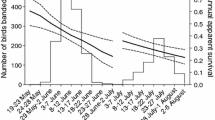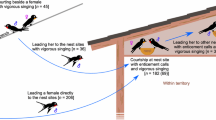Summary
There are large numbers of reproductively mature female tree swallows (Tachycineta bicolor) which do not breed due to limits of suitable nesting cavities. Many of these floaters are one-year-old females that have a distinctive subadult plumage. This study examines the behavioral tactics that these subadult female floaters use to obtain breeding opportunities. Early in the season, subadult floaters tended to intrude briefly (Fig. 4) on many nest sites in succession (Figs. 2, 3), although they rarely gained close access to nest sites (Fig. 5). Subadults responded very quickly to vacant nest sites, where the resident female had been experimentally removed, by entering the nest cavity and defending it from conspecifics. We argue that the early season exploratory behavior increases a subadult's chances of discovering a vacant nest site, rather than increasing its success in evicting resident females or laying eggs in other females' nests. During the nestling period, subadult females intruded on fewer nest sites for longer periods, and often gained close access to the nest site. Late in the season, subadult floaters may be gathering information on the quality of nest sites for the next breeding season, rather than searching for current breeding opportunities. The reproductive tactics of subadult female tree swallows are consistent with the breeding threshold model for the evolution of delayed plumage maturation in passerines.
Similar content being viewed by others
References
Bent AC (1942) Life histories of North American flycatchers, larks, swallows and their allies. Dover, New York
Beecher MD, Beecher IM (1979) Sociobiology of bank swallows: reproductive strategy of the male. Science 205:1282–1285
Birkhead TR (1982) Timing and duration of mate guarding in magpies, Pica pica. Anim Behav 30:227–283
Brown JL (1969) Territorial behavior and population regulation in birds. Wilson Bull 81:293–329
Brown CR (1984) Laying eggs in a neighbor's nest: benefit and cost of colonial nesting in swallows. Science 224:518–519
Burtt EH Jr, Tuttle RM (1983) Effect of timing of banding on reproductive success of Tree Swallows. J Field Ornithol 54:319–323
DeSteven D (1978) The influence of age on the breeding biology of the Tree Swallow Iridoprocne bicolor. Ibis 120:516–523
DeSteven D (1980) Clutch size, breeding success, and parental survival in the Tree Swallow (Iridoprocne bicolor). Evolution 34:278–291
Dominey WJ (1984) Alternative mating tactics and evolutionarily stable strategies. Am Zool 24:385–396
Eadie J MCA, Gauthier G (1985) Prospecting for nest sites by cavity-nesting ducks of the genus Bucephala. Condor 87:528–534
Emlen ST (1984) Cooperative breeding in birds and mammals. In: Krebs JR, Davies NB (eds) Behavioural ecology and evolutionary approach, 2nd ed. Sinauer, Massachusetts, pp 305–339
Flood NJ (1984) Adaptive significance of delayed plumage maturation in male Northern Orioles. Evolution 38:267–279
Gowaty PA (1981) Aggression of breeding Eastern Bluebirds (Sialia sialis) toward their mates and models of intra-and interspecific intruders. Anim Behav 29:1013–1027
Gowaty PA, Karlin AA (1984) Multiple maternity and paternity in single broods of apparently monogamous Eastern Bluebirds (Sialia sialis). Behav Ecol Sociobiol 15:91–95
Hannon SJ, Zwickel FC (1979) Probable non-breeders among female Blue Grouse. Condor 81:78–82
Hansen AJ, Rohwer S (1986) Coverable badges and resource defense in birds. Anim Behav 34:69–76
Holroyd GL (1975) Nest site availability as a factor limiting population size of swallows. Can Field Nat 89:60–64
Hurly TA, Robertson RJ (1984) Aggressive and territorial behaviour in female Red-winged Blackbirds. Can J Zool 62:148–153
Hussell DJT (1983) Age and plumage colour in female Tree Swallows. J Field Ornithol 54:312–318
Leffelaar D, Robertson RJ (1985) Nest usurpation and female competition for breeding opportunities by Tree Swallows. Wilson Bull 97:221–224
Lombardo MP (1986b) A possible case of adult intraspecific killing in the Tree Swallow. Condor 88:131
Lombardo MP (1986b) Attendants at Tree Swallow nests. I. Are attendants helpers at the nest? Condor 88:297–303
Lombardo MP (1987) Attendants at tree swallow nests. II. The exploratory-dispersal hypothesis. Condor 89:138–149
Lyon BE, Montgomerie RD (1986) Delayed plumage maturation in passerine birds: reliable signalling by subordinate males? Evolution 40:605–615
Muldal A, Gibbs HL, Robertson RJ (1985) Preferred nest spacing of an obligate cavity-nesting bird, the Tree Swallow. Condor 87:356–363
Murton RK, Westwood NJ (1977) Avian breeding cycles. Clarendon Press, Oxford
Nilsson SG (1984) The evolution of nest-site selection among hole-nesting birds: the importance of nest predation and competition. Ornis Scandinavica 15:167–175
Procter-Gray E, Holmes RT (1981) Adaptive significance of delayed attainment of plumage in male American Redstarts: tests of two hypotheses. Evolution 35:742–751
Robertson RJ, Gibbs HL (1982) Superterritoriality in Tree Swallows: a reexamination. Condor 84:313–316
Robertson RJ, Gibbs HL, Stutchbury BJ (1986) Spitefulness, altruism, and the cost of aggression: evidence against superterritoriality in Tree Swallows. Condor 88:123–124
Rohwer S, Fretwell SD, Niles DM (1980) Delayed maturation in passerine plumages and the deceptive acquisition of resources. Am Nat 115:400–437
Rutberg AT, Rohwer S (1980) Breeding strategies of male Yellow-headed Blackbirds: results of a removal experiment. Auk 97:619–622
Saether B, Fonstad T (1981) A removal experiment showing unmated females in a breeding population of Chaffinches. Anim Behav 29:637–639
Searcy WA, Yasukawa K (1983) Sexual selection and Redwinged Blackbirds. Am Sci 71:166–174
Selander RK (1965) On mating systems and sexual selection. Am Nat 99:129–141
Selander RK (1972) Sexual selection and dimorphism in birds. In: Cambell BG (ed) Sexual selection and the descent of man (1981–1971). Aldine, Chicago, pp 180–230
Smith SM (1978) The “underworld” in a territorial sparrow: adaptive strategy for floaters. Am Nat 112:571–582
Studd MV, Robertson RJ (1985) Life span, competition, and delayed plumage maturation in male passerines: the breeding threshold hypothesis. Am Nat 126:101–115
Stutchbury BJ, Robertson RJ (1985) Floating populations of female Tree Swallows. Auk 102:651–654
Stutchbury BJ, Robertson RJ (1986) A simple trap for catching birds in nest boxes. J Field Ornithol 57:64–65
Stutchbury BJ, Robertson RJ (1987) Two methods of sexing adult Tree Swallows before they begin breeding. J Field Ornithol 58:236–242
Weatherhead PJ, Robertson RJ (1980) Sexual recognition and anti-cuckoldry behavior in savannah sparrows. Can J Zool 58:991–996
Wittenberger JF (1979) A model for delayed reproduction in iteroparous animals. Am Nat 114:439–446
Author information
Authors and Affiliations
Rights and permissions
About this article
Cite this article
Stutchbury, B.J., Robertson, R.J. Behavioral tactics of subadult female floaters in the tree swallow. Behav Ecol Sociobiol 20, 413–419 (1987). https://doi.org/10.1007/BF00302984
Received:
Accepted:
Issue Date:
DOI: https://doi.org/10.1007/BF00302984




